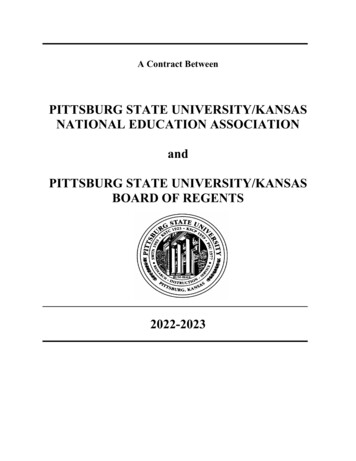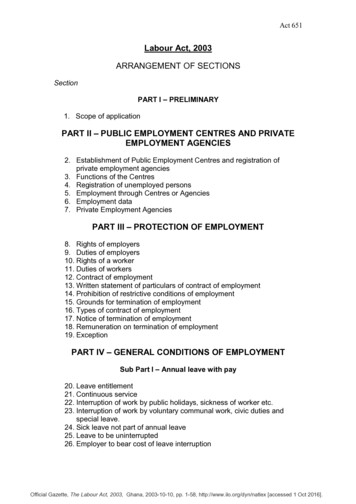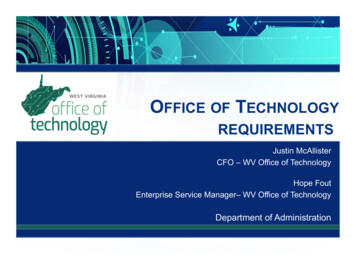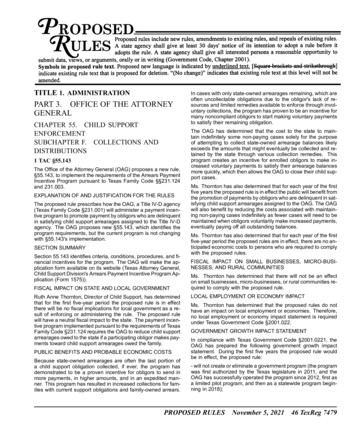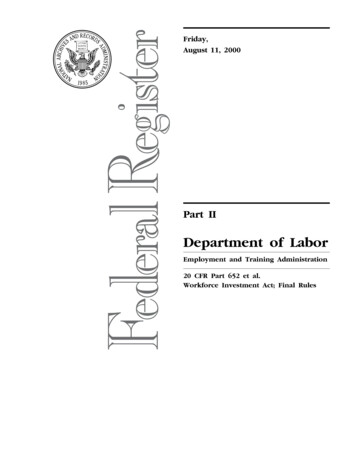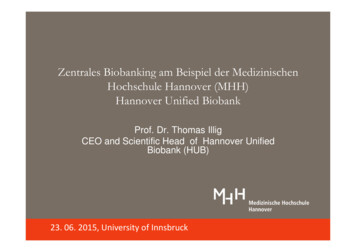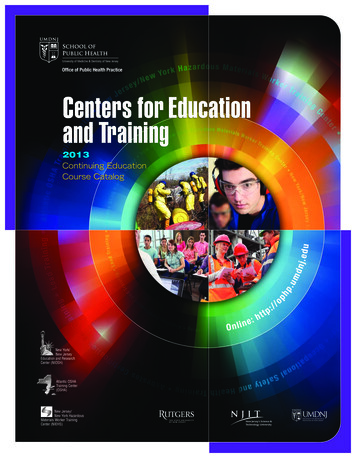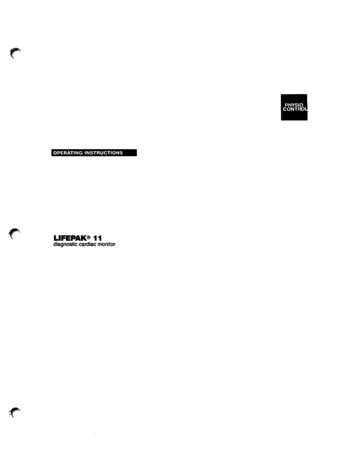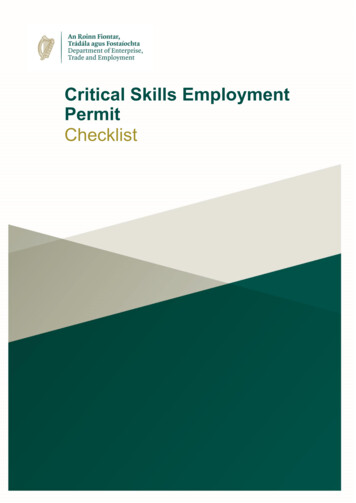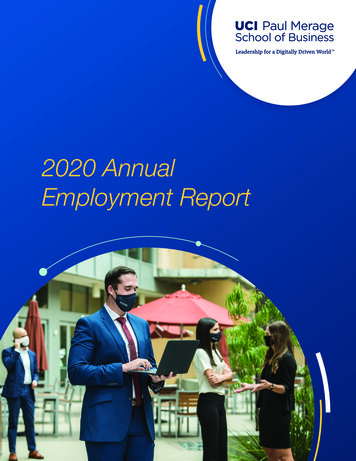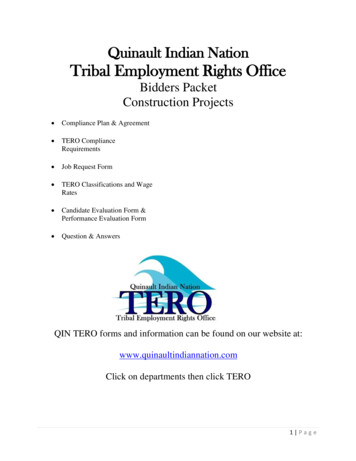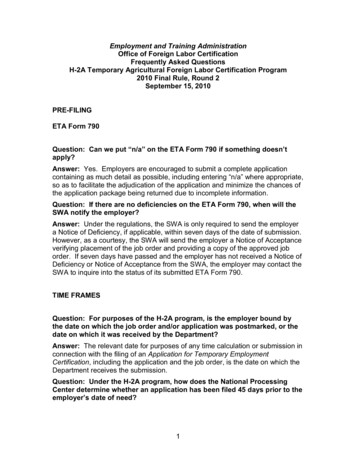
Transcription
Employment and Training AdministrationOffice of Foreign Labor CertificationFrequently Asked QuestionsH 2A Temporary Agricultural Foreign Labor Certification Program2010 Final Rule, Round 2September 15, 2010PRE FILINGETA Form 790Question: Can we put “n/a” on the ETA Form 790 if something doesn’tapply?Answer: Yes. Employers are encouraged to submit a complete applicationcontaining as much detail as possible, including entering “n/a” where appropriate,so as to facilitate the adjudication of the application and minimize the chances ofthe application package being returned due to incomplete information.Question: If there are no deficiencies on the ETA Form 790, when will theSWA notify the employer?Answer: Under the regulations, the SWA is only required to send the employera Notice of Deficiency, if applicable, within seven days of the date of submission.However, as a courtesy, the SWA will send the employer a Notice of Acceptanceverifying placement of the job order and providing a copy of the approved joborder. If seven days have passed and the employer has not received a Notice ofDeficiency or Notice of Acceptance from the SWA, the employer may contact theSWA to inquire into the status of its submitted ETA Form 790.TIME FRAMESQuestion: For purposes of the H 2A program, is the employer bound bythe date on which the job order and/or application was postmarked, or thedate on which it was received by the Department?Answer: The relevant date for purposes of any time calculation or submission inconnection with the filing of an Application for Temporary EmploymentCertification, including the application and the job order, is the date on which theDepartment receives the submission.Question: Under the H 2A program, how does the National ProcessingCenter determine whether an application has been filed 45 days prior to theemployer’s date of need?1
Answer: When determining whether an application has been filed “no less than45 calendar before employer’s date of need,” as required by 20 CFR 655.130(b),the National Processing Center does not include the day the application wasreceived in its calculation. Instead, the next day is counted as day one. Forexample, if an application is received at the National Processing Center onTuesday, June 1, 2010, that date is not counted. Instead, Wednesday, June 2nd,is counted as day 1 of the timeframe and Thursday, June 3rd, as day 2; etc., upuntil Friday, July 16th, which is day 45. In this instance, provided the employerlists its date of need on its submitted application as July 16, 2010, or after, theemployer has complied with 20 CFR 655.130(b).FILINGETA Form 9142Question: Where do I find the NAICS Code requested in Section C,question 13 of the ETA Form 9142, and what is it?Answer: The North American Industry Classification System (NAICS) is thestandard used by Federal statistical agencies in classifying businessestablishments for the purpose of collecting, analyzing, and publishing statisticaldata related to the U.S. business economy. The NAICS coding system ismaintained by the U.S. Census Bureau. A listing of NAICS codes can be foundat http://www.census.gov/epcd/www/naics.html. The code selected by theemployer should reflect the nature of the employer’s business, not the job forwhich certification is sought.Question: You added several new questions to the ETA Form 9142,including the year the company started, its gross annual revenue, and thenumber of non family full time equivalent (FTE) employees. Willapplications be rejected if this information is not included? Shouldtemporary/seasonal employees be included in the non family FTE count?Answer: Applications will not be rejected if questions, such as those listedabove, are not answered as long as they are not required fields/items containingan asterisk (*). Additionally, temporary and/or seasonal workers should not beincluded in the non family FTE count.Question: Must an employer list the location of the worksite if it is alreadylisted in the ETA Form 790?Answer: Yes. Both the job order and the ETA Form 9142 must list eachworksite where the workers will be working so that they may be apprised of thelocations prior to applying for the job opportunity.JOB OFFERS, ASSURANCES AND OBLIGATIONS2
HousingQuestion: Is the H 2A employer required to provide housing to U.S.workers who live within normal commuting distance from the worksite, butlive in a homeless shelter or no longer want to pay rent?Answer: The regulations require the employer to provide housing only for thoseworkers who are not reasonably able to return to their residence within the sameday. A homeless shelter does not qualify as a person’s “residence” because ashelter, by its very nature, is temporary. Therefore, in an instance where aworker is living in a homeless shelter, the employer must offer such workerhousing. However, the employer is not required under the regulations to providehousing to a worker who is able to return to his or her residence within the sameday but who no longer wants to incur the price of rent.Question: What if the SWA refuses to do housing inspections?Answer: SWAs receive grants from the Employment and TrainingAdministration to perform all of the duties necessary under the Office of ForeignLabor Certification’s (OFLC) programs, including conducting housing inspectionsin a timely manner. The regulations now permit employers to request thehousing inspections well in advance of the date of need. If a SWA refuses toconduct the housing inspection, employers should contact the Chicago NationalProcessing Center.Workers’ Compensation Insurance CoverageQuestion: When do I need to submit proof of workers’ compensationinsurance coverage?Answer: Pursuant to 20 CFR 655.122(e)(2), the employer is required to submitproof of workers’ compensation insurance coverage before certification. Theemployer is encouraged to include the documentation when submitting itsapplication. If the employer does not have the documentation ready at the time itsubmits the application, the employer will be directed by a Notice of Acceptanceto submit the documentation by a specific date before certification may begranted.Question: What documentation should I submit as evidence of workers’compensation insurance coverage?Answer: The employer must submit documentation that adequatelydemonstrates that it has the required workers’ compensation insurance coveragefor the entire period of need requested on the application. (See 20 CFR655.122(e))The documentation submitted must demonstrate that the employer’s workers’compensation insurance coverage is in compliance with State law and covers3
injury and disease arising out of and in the course of the worker’s employment.In addition, the documentation submitted must contain the name of the insurancecarrier, the insurance policy number, and proof of insurance for the period ofneed stated on the application, or, if appropriate, proof of State law coverage.Examples of acceptable documentation of workers’ compensation insurancecoverage include, but are not limited to, the following: Association for Cooperative Operations Research and Development(ACORD) Certificate of InsuranceState Workers’ Compensation Fund Certificate or equivalentCertificate of Insurance indicating worker’s compensation coverage (copyof policy)Question: My workers’ compensation insurance coverage expires prior tomy end date of need. What documentation should I submit as proof ofcoverage for the entire period of need requested on the application?If the employer’s current workers’ compensation insurance coverage will expirebefore the end date of need requested on the application, the employer mustsubmit a signed and dated written statement showing its intent to renew andmaintain coverage for entire period of need requested on the application. Thewritten statement must be submitted in addition to the documentation of theemployer’s current coverage described above. Also, the employer must retainthe proof of renewed coverage in its file and be prepared to submit suchdocumentation if requested.MealsQuestion: Under the 2010 Final Rule the employer is required to provide toits workers either three meals a day or free and convenient cooking andkitchen facilities. What constitutes a meal for purposes of the 2010 FinalRule?Answer: An employer providing three meals a day to its workers must provide areasonable balance of food groups and nutrients intended to supply sufficientnutrition to the workers three times a day. The Department advises employers toconsult the United States Department of Agriculture’s Dietary Guidelines forAmericans 2005 report (in effect until the publication of the new report in 2010)that may be accessed or downloaded through the following web Guidelines/2005/2005DGPolicyDocument.pdfIn addition, the employer may only charge the workers for the actual cost of themeals and may not profit from the provision of food. This amount may not4
exceed the amount specified in 20 CFR 655.173, currently set at 10.64 for threemeals a day, absent a successful petition for a higher meal charge.Transportation and Daily SubsistenceQuestion: What is the definition of daily subsistence for purposes of travelpayments/reimbursement?Answer: Daily subsistence includes, but is not limited to, the reasonable cost offood and lodging incurred during the worker’s inbound trip from the point ofrecruitment to the employer’s worksite, notwithstanding any unauthorizeddetours, and during the worker’s outbound trip from the employer’s worksite tothe worker’s home or subsequent employment, notwithstanding any unauthorizeddetours, whichever is applicable.No Strike or LockoutQuestion: Under the 2010 Final Rule I am not allowed to import H 2Aworkers if my domestic workers are on strike or if they are being lockedout. Is there a threshold number of workers that must be on strike for thisprohibition to apply?Answer: Yes. The prohibition against importing foreign workers when theemployer’s domestic workers are on strike or are being locked out applies to anylabor dispute involving two or more domestic workers. Any employer engaged insuch a dispute at the time the employer seeks to apply for the labor certificationmay not apply to import H 2A foreign workers.Question: What if my domestic workers go on strike after I’ve alreadyapplied to bring in the foreign workers?Answer: Section 218(b) of the Immigration and Nationality Act (INA) requiresthe Secretary to deny a labor certification if there is a strike or lockout in thecourse of a labor dispute. An employer seeking to employ H 2A workers mustagree that it will abide by the requirements and assurances outlined in 20 CFR655.135, including that the worksite does not have workers on strike or beinglocked out in the course of a labor dispute. Therefore, if the employer’s workersgo on strike after the employer filed its application but before the laborcertification is granted, the employer must notify the Department of the strike orlockout and/or withdraw its application until such a time as the labor dispute isresolved.Question: What happens if my domestic workers go on strike or are beinglocked out after I have received a labor certification and my H 2A workersare on their way to the worksite or are already working on the farm?5
Answer: Absent material misrepresentation or fraud in connection with theapplication within the meaning of the 2010 Final Rule, the employer maycontinue to employ H 2A workers notwithstanding a strike by its non H 2Aworkers. Lock outs resulting from a labor dispute will be analyzed on a case bycase basis to determine whether they warrant debarment under 20 CFR655.182(d). Also, if a lock out meets the definition of a layoff and if it occurswithin 60 days of the first date of need, section 20 CFR 655.135(g) requires thatthe U.S. workers be offered the job opportunity listed in the Application forTemporary Employment Certification before the H 2A workers. Therefore, unlessthe employer has sufficient work to be performed by all the laid off U.S. workersand the H 2A workers, the employer will need to dismiss the H 2A workers.Fifty Percent RuleQuestion: I am applying for a temporary employment certification to importH 2A workers to work on my farm and I understand that under the 2010Final Rule, there is a different requirement regarding the duration of theperiod during which I have to receive referrals of U.S. workers. How doesthe new requirement work?Answer: Under the 2010 Final Rule, the Department reinstated a long standingH 2A program component from the 1987 Final Rule that requires employers tocontinue to consider for employment and hire any qualified and eligible U.S.worker who applies for the position up until the end of the first half of the contractperiod, as identified on the Agricultural and Food Processing Clearance Order,ETA Form 790, as well as on the Application for Temporary EmploymentCertification, ETA Form 9142. This program component is referred to as the 50percent rule. Previously, under the 2008 Final Rule, employers were onlyrequired to accept U.S. applicants for the first 30 days of the contract period.Question: What is meant by an employer not being “otherwise associatedwith” other employers applying to import H 2A workers?Answer: As discussed above, an employer who is a member of an associationwhich has applied for a labor certification on behalf of its members is not exemptfrom the 50 percent rule. Similarly, an employer who technically is not a memberof an association but otherwise maintains a relationship with other employerswho are either members of an association that has applied for a laborcertification and/or who have individually applied for a labor certification, suchthat this employer together with the other employers forms an informal group thateffectively operates as an association – i.e., shares employees – would beconsidered to have “otherwise associated with other employers” and thus wouldnot be exempt from the 50 percent rule.Question: Should an employer who wishes to claim the small businessexemption submit documentation substantiating eligibility with itsapplication and/or job order?6
Answer: The Department is not requiring that an employer submit supportingdocumentation with its application at the time of filing, but the employer must inthe application certify to the Certifying Officer that the small business exemptionapplies and be prepared to provide documentation in support of such a claim ifrequested through an audit or investigation. However, the employer should notifythe SWA if it wishes to claim the exemption at the time it submits the job order forintrastate clearance and include such documentation as the SWA requires. Thiswill ensure that the SWA will not refer applicants to that employer for the durationof the 50 percent of the contract period.H 2A LABOR CONTRACTORSQuestion: What is the difference between an H 2A Labor Contractor and aFarm Labor Contractor?Answer: An H 2A Labor Contractor (H 2ALC) is any person who meets thedefinition of employer under 20 CFR 655.103(b) and is not a fixed site employer,an agricultural association, or an employee of a fixed site employer or agriculturalassociation, who recruits, solicits, hires, employs, furnishes, houses, ortransports any worker(s) subject to section 218 of the Immigration and NationalityAct.A Farm Labor Contractor (FLC), as defined under the Migrant and SeasonalWorker Protection Act (MSPA), is any person, other than an agriculturalemployer, an agricultural association, or an employee of an agricultural employeror agricultural association, who, for any money or other valuable considerationpaid or promised to be paid, performs any farm labor contracting activity.MSPA applies separately from the Department’s H 2A regulations at 20 CFR part655, Subpart B. Under the requirements of MSPA, FLCs (and any employeewho performs farm labor contracting functions) must register with the Departmentbefore recruiting, soliciting, hiring, employing, furnishing, or transporting anymigrant or seasonal agricultural worker. Agricultural employers and associations(and their employees) need not register as FLCs.POSITIVE RECRUITMENT AND HIRING OF U.S. WORKERSInterviewsQuestion: I have received referrals from the SWAs who know very littleabout the job opportunity. Under the Department’s regulations, may Ireject those workers for not being fully apprised of the job opportunity?7
Answer: No. Under the 2010 Final Rule and historically in the H 2A program,the employer has an affirmative obligation to apprise all workers, including H 2Aworkers and workers in corresponding employment of all material terms andconditions of employment. The Department’s regulations, at 20 CFR 655.122(q),additionally require each employer to provide its H 2A workers and workers incorresponding employment with a copy of the work contract (or in the absence ofa separate work contract, with a copy of the application and job order) in alanguage understood by the worker. Finally, rejections of U.S. workers whoapply for the job must be only for lawful, job related reasons – not being aware ofall the terms and conditions of employment is not a lawful, job related reason tonot hire an otherwise qualified and eligible U.S. worker.POST FILINGAmendmentsQuestion: If an employer or association of employers realizes that it needseither more or fewer H 2A workers than stated on the ETA Form 9142, howlate in the process can it request a change?Answer: Employers may request to amend, i.e., to either increase or decrease,the number of workers requested in their initial application at any time before finaldetermination. Employers may request an increase in the number of workerswithout additional recruitment as long as the increase is no more than 20 percentof the original number requested or 50 percent in the case of an employerrequesting less than 10 workers. For requests for increases above thepercentages prescribed, without additional recruitment, the employer mustdemonstrate that the need for additional workers could not have been foreseen,and the crops or commodities will be in jeopardy prior to the expiration of anadditional recruitment period.WithdrawalsQuestion: May I withdraw a job order I submitted to the SWA once it hasbeen accepted into intrastate clearance?Answer: Yes. An employer who submitted a job order in connection with afuture H 2A application may withdraw it once it has been accepted for intrastateclearance but before the employer files an Application for TemporaryEmployment Certification, ETA Form 9142 with the Chicago National ProcessingCenter, but the employer’s withdrawal of the job order does will not nullifyexisting obligations to workers who were recruited in connection with that joborder. If the employer received SWA referrals pursuant to the withdrawn joborder and successfully recruited U.S. workers, the employer will be bound by the8
terms and conditions of employment reflected in the job order with respect tothose workers, including but not limited to wages, housing, and transportation.Question: May I withdraw my Application for Temporary EmploymentCertification and job order after filing an Application for TemporaryEmployment Certification with the Chicago NPC?Answer: Yes. An employer may withdraw its Application for TemporaryEmployment Certification and job order submitted in connection with theapplication, after the job order is accepted by the SWA and placed intrastateclearance, but before the Certifying Officer issues a Notice of Acceptance.However, the employer will be required to comply with the terms and conditionsof employment contained in the job order with respect to workers recruited inconnection with that application and job order.Question: May I withdraw my Application for Temporary EmploymentCertification and job order after I receive a Notice of Acceptance from theChicago NPC?Answer: Yes. An employer may withdraw its Application for TemporaryEmployment Certification and job order submitted in connection with theapplication after the Certifying Officer issues a Notice of Acceptance. Theemployer will be required to comply with the terms and conditions of employmentcontained in the application and job order with respect to workers recruited inconnection with that application and/or job order.9
655.135, including that the worksite does not have workers on strike or being locked outin the course of a labor dispute. Therefore,if the employer's workers go on strike after the employer filedits application but before thelabor
